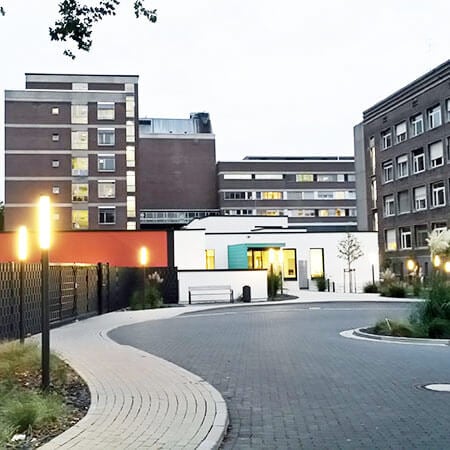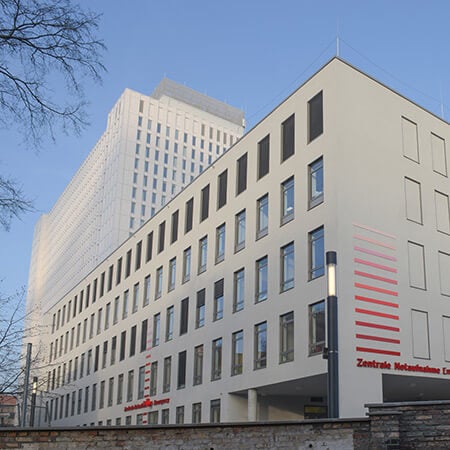Inguinal hernia
Due to the difficulties associated with the organization of treatment in Turkey, Switzerland, South Korea and India, we are not currently processing requests to these regions.
If you are interested in treatment in Germany, please leave a request and our specialists will contact you as soon as possible.
Inguinal hernia is a pathological state of health peculiar with the formation of a peritoneal protrusion into the inguinal canal cavity. Such protrusion (hernial sac) may contain abdominal organs or fat tissues. Males get it more often than females. Incidence of male inguinal hernia reaches 27% in some countries, while female hernia doesn’t exceed 3%.
The Booking Health portal presents 44 German clinics specializing in inguinal hernia treatment
Show all clinics
Inguinal hernia – Diagnostics
Diagnostics of inguinal hernia is done by a surgeon. Its aim is to reveal a formation, its exact location and type (oblique, direct or combined inguinal hernia).
Doctor indicates several ways of examination including:
- Examination of the anterior abdominal wall while patient is standing
- Positive symptom of «cough impulse» – protrusion increases in size when straining
- Palpation (palpation of tissues) in the area of the hernial sac and gates
If necessary, a surgeon may prescribe additional studies, including the ultrasound examination of the abdominal cavity and scrotum.
Best clinics for the inguinal hernia diagnostics in Germany:
Inguinal hernia – Treatment
Only radical treatment can be effective in the case of inguinal hernia. Hence, different ways of surgical intervention are applied to achieve the purpose. Operation is chosen individually for each patient taking into consideration the diagnostics results and the anatomical features of the inguinal canal.
Leading European medical centers apply following techniques for the radical treatment of inguinal hernia:
- Tension hernioplasty is rarely done in the modern hospitals because of the high recurrence risk in the long-term postoperative period. Doctors remove herniated sac, pull and stitch the hernia gate margins. Though future repeated breaks are possible in this area after intense physical exertion.
- Tension-free obstructive hernioplasty is a method of abdominal cavity tightening with the help of a special propylene mesh placement. A patient will restore work capacity even having a severe course of pathological condition and large size of the inguinal hernia.
Inguinal hernia – Innovative treatment
Constant work on the development of new ways of surgical treatment is ongoing. Purpose of such researches is:
- Shorter time of inpatient stay and rehabilitation
- Reduced risk of complications
- Reduced risk of recurrence
- Improved aesthetic effect
German hospitals mainly implement laparoscopic interventions to get rid of inguinal hernia, so the healthy tissues are almost not damaged.
Laparoscopic tension-free obstructive hernioplasty is a less invasive surgery. A surgeon uses a special tube with a camera, light and micro instruments. Access is gained through the small incisions, sufficient for inserting the laparoscope.
For radical treatment of inguinal hernia German specialists mainly perform laparoscopic interventions with hernioplasty or without it. Such treatment has the following benefits:
- Minimal damage of tissues
- No need in staying in the hospital – a patient goes home the same day
- Minimal risk of various complications, including bleeding
- Risk of recurrence is almost absent
Inguinal hernia can be completely cured in the modern surgical medical centers thanks to the benefits of the radical treatment.
Best clinics for the inguinal hernia treatment in Germany:


Inguinal hernia – Rehabilitation
Rehabilitation is the process of body restoration from injuries, surgeries or diseases. It can have a different orientation such as: oncological, orthopedic, neurological, etc. There is also general therapeutic rehabilitation. It is indicated for patients after conservative and surgical treatment of the internal organs diseases.
The directions of the general therapeutic rehabilitation
There are several main directions of the therapeutic rehabilitation such as:
- Medical one, which includes the restoration of patient's health, normalization of body functions, stimulation of compensatory possibilities, elimination of the chronic pain, etc.
- Physical one, which is responsible for improving of work capacity and tolerance for physical activities. In the complex cases, the purpose of this therapeutic rehabilitation area may be the restoration of the self-service ability.
- Psychological one, which helps to eliminate the mental disorders which may occur as a result of a disease (phobias, depression, apathy), to increase the human motivation, and to adapt to the changed living conditions.
The World Health Organization underlines 3 phases of rehabilitation such as: hospital phase, a phase of recovery and supporting phase. Different tasks are solved in different phases. The hospital phase is conducted immediately after the treatment. After the first phase begins the second one which usually takes place in sanatoriums or rehabilitation centers. This is the boundary between two periods, namely illness and future life. Then a supporting phase is required. The patient maintains the achieved level of his health and physical activity at home or visits the rehabilitation center from time to time.
Therapeutic rehabilitation methods
The most modern rehabilitation programs are used in Germany. They are adapted individually for each patient, and are based on the recent disease, age, physical possibilities, and the results of treatment. Different specialists such as: therapists, psychologists, rehabilitators, kinesiotherapists, physiotherapists are involved in the rehabilitation process.
The following methods of rehabilitation are used:
- Dosed physical activity
- Training on the simulators and in the pool
- Physiotherapy
- Acupuncture
- Manual therapy
- Microcurrent therapy
- Compression therapy
- Lymphatic drainage
- Natural factors of the nature (mud, thermal waters, etc.)
Any rehabilitation may include medicamentous support. It is necessary to hold a consultation with the patient about the proper nutrition and the way of life which is important for him in the current situation.
Rehabilitation programs in Germany are designed for 2 weeks. If necessary, they can last much longer. In this country, the patient is provided with qualitative care, accommodation in comfortable rooms and individually selected meals.
Rehabilitation programs in Germany show one of the best results in the world. Most patients successfully restore their employability and excellent health there. They remain physically active, return to the full social and family life.
Best clinics for general therapeutic rehabilitation in Germany:
Author:
The article was edited by medical expert, board certified Dr. Nadezhda Ivanisova. For the treatment of the conditions referred to in the article you must consult a doctor; the information in the article is not intended for self-medication!
Sources:
The cost of services includes
Here you can find the cost of treatment for this disease at the German University Hospitals. Leave a request and we will provide a free consultation with a doctor and will start organizing the whole treatment process.
The program includes the following:
- Issuing of an invitation for getting a visa for treatment as quick as possible
- Fixing an appointment at a time convenient for you
- Preliminary organization of a comprehensive examination and discussion of the forthcoming treatment plan
- Arranging transfer from the airport to the hospital and back to the airport
- Provision of interpreting services and services of a personal medical coordinator
- If necessary, assistance in the organization of further surgical treatment
- Provision of a medical insurance against treatment complications covering up to 200,000 euro
- Preparation and translation of medical records and recommendations from the hospital
- Assistance in the subsequent communication with your attending physician, including consultations on repeated X-ray images through the unique medical document management system E-doc



